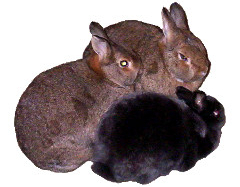
|
|||
|
|
|
|
|
Outdoor Housing
|
Successful Outdoor Housing As no one in 3bunnies.net really knows that much about outdoor housing, we are going to allow our readers contribute their ideas until a decent article can be written. Remember, the average life span of an indoor rabbit is 8 to 12 years, and we've seen up to age 19. We received this email from one of our readers who has been very successful in having rabbits outdoors. The life span of these rabbits is up to 4-6 years My rabbits are personally housed underneath our one story addition. The addition is enclosed in lattice, so basically it's like the underneath of a deck, but with a solid roofing. When a rabbit lives outdoors they must be housed out of direct sunlight, wind, rain, and snow. Basically somehere outdoors that the elements will not reach them, i.e a shed, or under the dack, or addition, on the side of the house where the wind will not be or where the least sun is. Most all of our rabbits are in 2' X 3.5' hutches, with a wooden nesting area that is roughly 1/3 of the cage. The hutches have pull out trays that we put pine shavings in, so it soaks up the urine. The cages are cleaned every day, just as indoor bunnies homes arre. Since the bottom of the hutches is wire, except for the nesting part which is wood, we give them woven grass mats to rest their paws on. They can use it for a yummy snack too! We use metal food and water bowls that attach to the cage wire. Rabbits need water at all times, as you know, so in the winter, when the bowls freeze, luke warm water is needed for the bowls, this will make it so the water will take more time to get icy, and it warm up the bunny too! We feed Blue Seal Bunny 16, and we add a large can of oats per 25lbs of food, this gives them a little extra calories and meat on their bones in the winter. We feed our rabbits papaya complete tablets, papaya is good for helping them digest and hold on to the proteins they get from their food. This is not necessary by any means, but I like to go out of my way for my rabbits. Our bunnies have toys just like indoor bunnies, and they have a pen set up just for them to be able to play in. Some of our does are bonded, which we feel it is best to have a bonded pair of bunnies living together if outdoors, they tend to keep eachother warm, of course bonded bunnies must be spayed and neutered, we don't need any mistake litters! We also give our rabbits little blankets if we feel they will need them that winter. Our addition where they are housed under is not only enclosed in lattice, but also a thick heavy plastic sheeting, since lattice has holes in it, in the winter we put this up to block out snow. Lattice brakes wind, but not snow! On days like this where the air is freezing.. the rabbits each get a whole chuck of hay to bury themselves in. Once the water bowls have a lot of ice in them, they need to be brought in and soaked in hot water to remove the ice. The water can not be hot!! Luke warm to warm only, hot water burns people toungues, imagine what it would do to a little bunny tongue! Now for summer: The summer is a different story. Bunnies start to get very stressed once temperatures get into mid 70's, and if a rabbit is out in the open in 80 degree weather, it can be fatal. We freeze water bottles and water jugs, and put them in the cages. the buns lay against them, and lick them and it does wonders at keeping them cool. We put ice cubes in the water. We use less hay, still hay in there hay racks to eat, but less for bedding, as it gets hot! Cages need to be kept extra extra clean, as it can start to smell with the heat. The hutches can be sprayed out with a hose weekly to reduce the smell, but make sure the bunny is out of the hutch when you are spraying, we don;t want to get the bunny wet. As you mentions, the bunny fan works well to cool them. But the main thing you need to stress is the importance of keeping them in the shade. In the summer under the addition it is about 10 degrees cooler, and in the winter about 10 degrees warmer. this helps the bunnies! Days where it is nearing 100 degrees, or the 90s... a put a little water on my hand, and simply wipe the water on the ears. This cools the bunny down as their ears are important to keep cool, this is where the bunny releases a lot of heat or will absorb the cool water. I let my bunnies out in their large pen to play too, they dig holes in the shade and fall asleep in the dirt, as its nice and cool.
Copyright ©2020
3 Bunnies Rabbit Resources All Rights Reserved About Us Contact Us Site Map This site is supported strictly by donations from our readers 
A Buck for the Bunnies Last update: Sun Jun 28 21:49:23 EDT 2020 |




